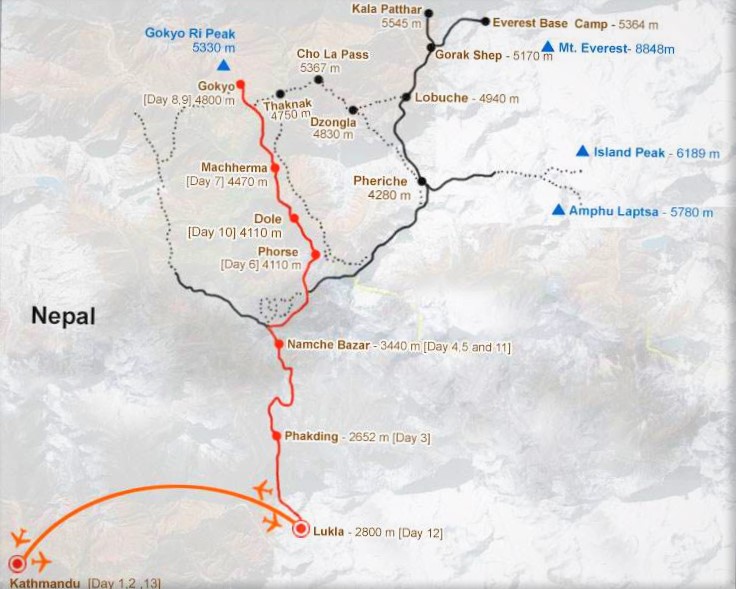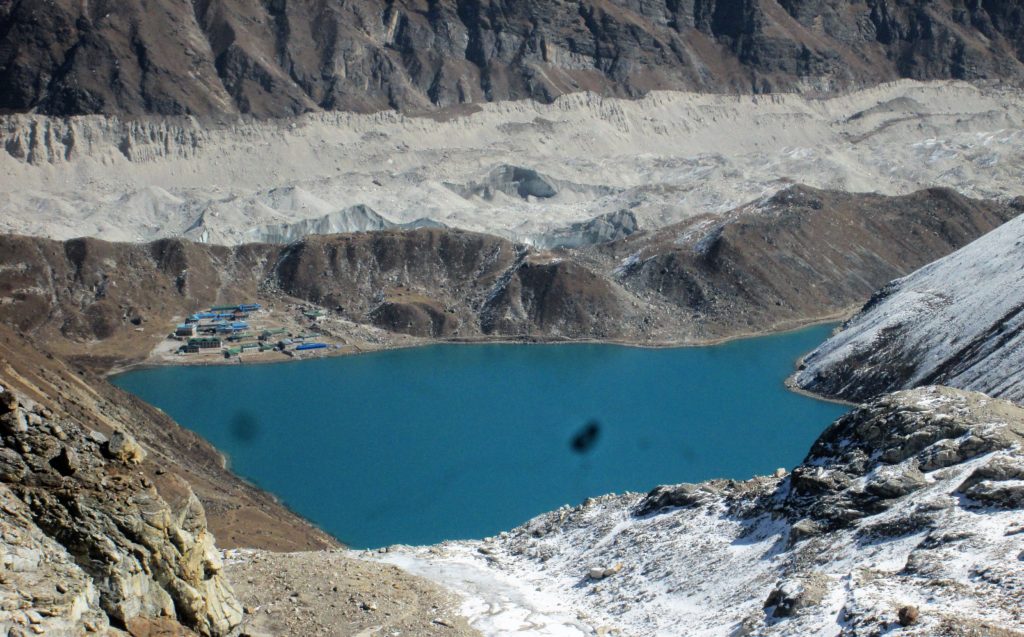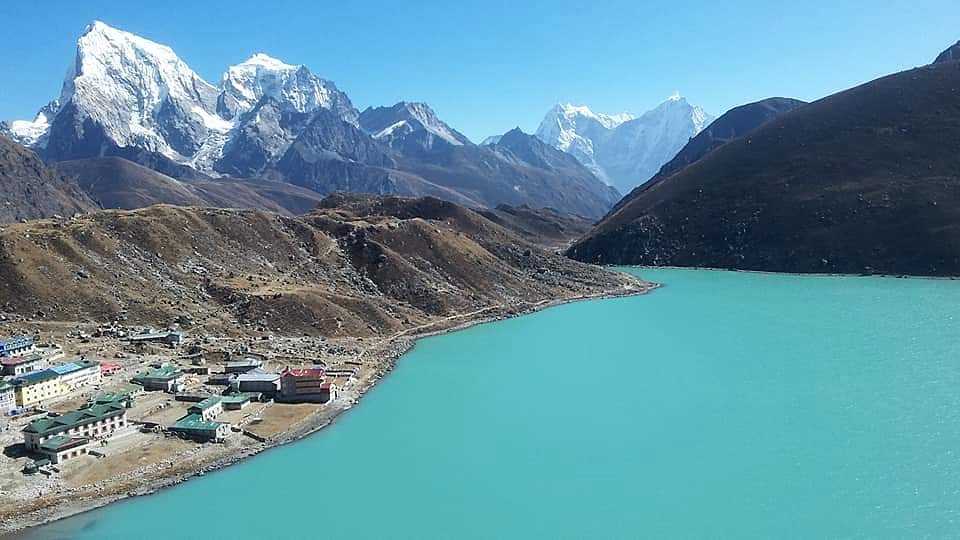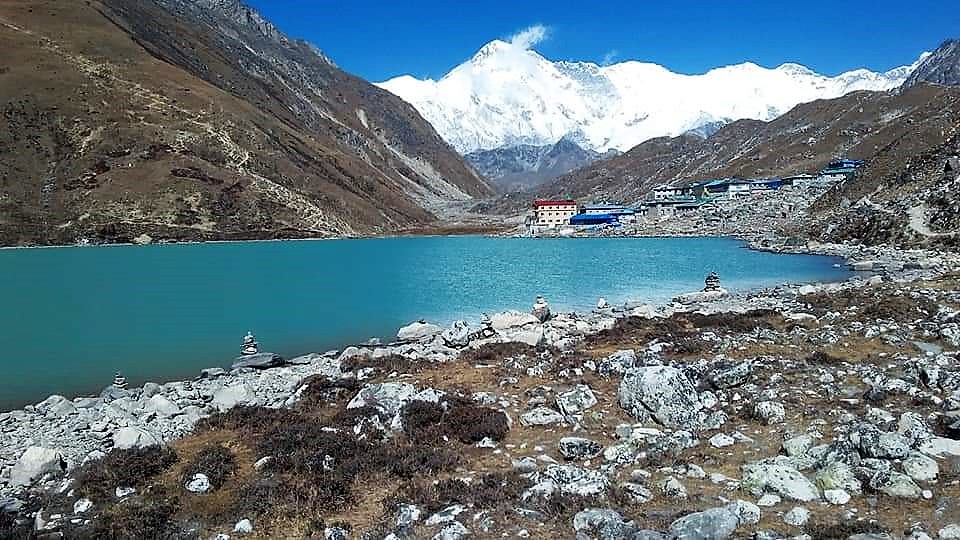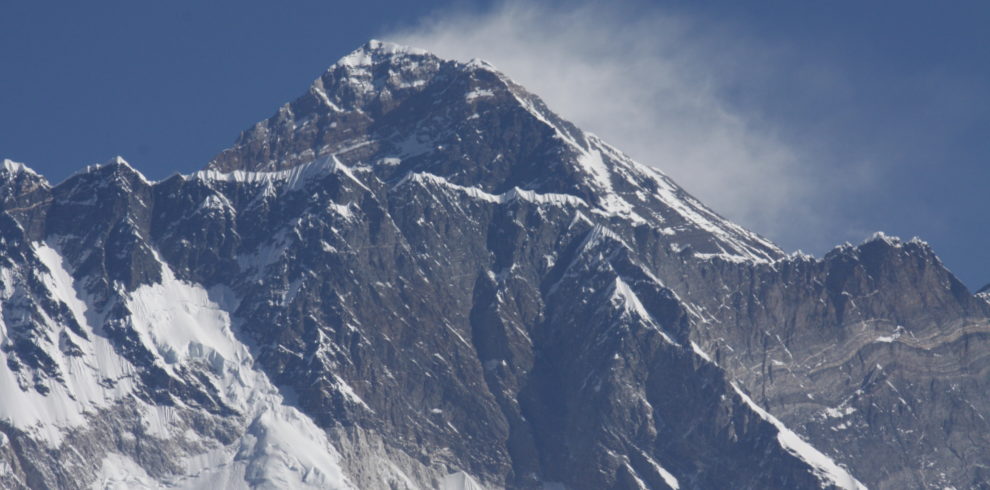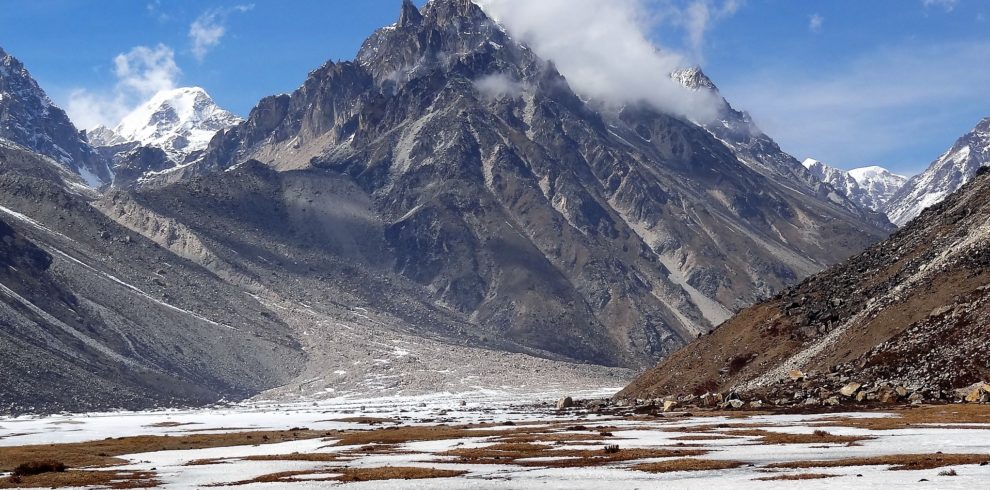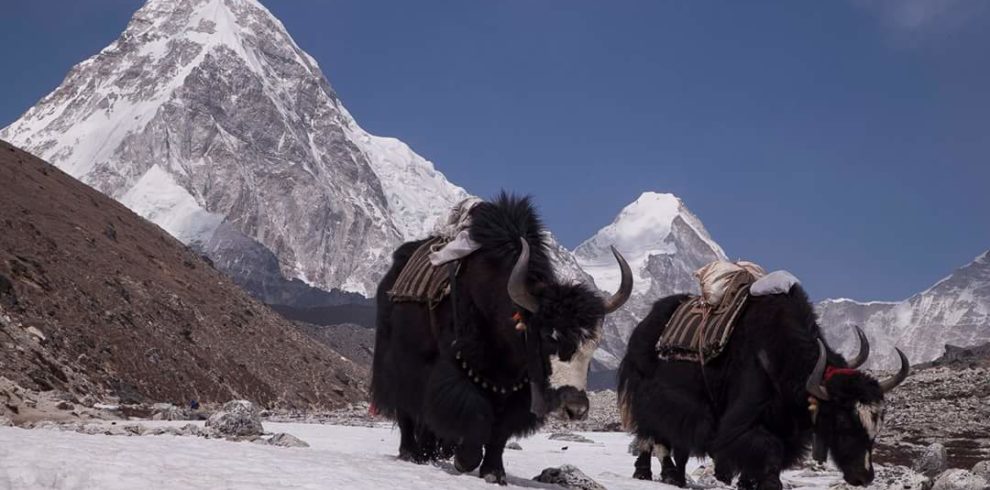Gokyo Valley Trek recognized for the series of a beautiful mountain with turquoise lakes. Our 12 days the famous Gokyo Ri hiking is an excellent trip to the Himalayas. Everest Valley trek is famous for picture squire 360 views of world tallest peaks in at once glance. That is why the Gokyo Trek route takes us through the landmarks of the Khumbu region. Trek evokes us majestically soaring mountains, friendly Sherpas, colorful monasteries.
The Trek in advancing to the base of the world’s tallest mountain maps out spectacular vistas from such celebrated viewpoints like Gokyo Ri. The Gokyo lake trek awards us with great views of the Ngozumpa glacier from the viewpoint of Nepal. Trekking to the Gokyo Lakes, in a nutshell, will be a lifetime experience with the enthralling sights of Mt. Cho Oyu, Everest, Lhotse, Makalu, Nuptse, Amadablam, Pumori. Whereas, the Ngozumpa glacier of Valley is the largest in Nepal.
Gokyo Valley Trek’ Itinerary is famous for an ideal short Holiday. Hikers, who wish to take more challenges and “stay off the beaten path” while treading upon the remote trip, this is best for them. However, if you are a novice trekker who is in good health and average physical fitness. Then we can do both in combining 16 days Gokyo Chola Pass Trek might be right for you.
Gokyo Valley Kongma la Pass Trek
We have various Gokyo and Kongmala pass trek itineraries on an adjoining basis. Please sign up for Everest Base Camp Short Trek – 14 Days instead if you won’t want to do only Gokyo. Trek Permit us to add different trek in the Everest route on a long days trip. Gokyo Ri is the best viewpoint trek tp see the beautiful Himalayas. Also, we have Gokyo Chola pass trek for longer days itinerary. Everest hiker has various Everest valley and Gokyo Ri trek reviews regarding this trip.
Additionally, if you are an experienced trekker continue to trek to the Everest Base Camp is the best one. But it’s a short trek for limited days that offers all the scenic view of Valley. The Trek entry point of the Namche Bazaar, Sagarmatha National Park, and of course, to the base of the mighty Everest.
Overview
Dramatic take on/off in Lukla gateway Gokyo and Ebc Trek
Sherpa Culture and tradition hub
Many High suspension Hanging Bridges during the trek
Tibetan Buddhism and practice
Closure view of Himalaya route to Gokyo Valley
Highest Gokyo Ri Viewpoint highest Mountain Khambu (roof of the world)
Breathtaking view from Mt Everest Mt Makalu Gokyo Valley Lake and Glaciers
Comfortable Accommodation and hygiene meals every day served
Acute Mountain Sickness friendly itinerary
Scenic Mountain flights from Lukla to Kathmandu
Trekking in the famed Everest Valley
Closure view of Himalayas in route to Everest Base Camp
Explore Namche Bazaar, the capital of the Sherpa people
Explore Khumjung Village and the museum, Hilary School
Magnificent view, Gokyo Valley Lake and Glaciers
Watching the world’s highest Mt Everest with Mt Ama Dablam and more
Gokyo Ri and surrounding
Itinerary
The early day we start tour Pashupatinath temple, Swayambhunath stupa and Bouddhanath stupa which are all world heritage sites. The Durbar Square sheds light on the life of the Gorkha royals in ancient times, which we can explore by some short of hiking, Pashupatinath temple is one of the most important places of pilgrimage for all Hindus religious. Swayambhunath is also known as the Monkey Temple and Boudhanath Stupa is one of the largest stupas in the world, where we can view most of the valley and surrounding mountains. At noon, we are introduced to our trekking guide team and discuss the trek in Explore Manaslu team. Overnight in Kathmandu.
We take an early morning adventures flight to Lukla your Everest three pass trek to begin now. We meet the rest of our team in Lukla after breakfast we start our trek. We walk on a trail that gradually descends to Cheplung village from where we get a glimpse of Mt. Khumbila, and Rhode a sacred mountain which has never been allowed to climb until now. From here, we gradually descend until Phakding village. Overnight in Phakding.
Included meals: Breakfast Lunch Dinner in the same lodge.
Our trail leads through a pine forest and edge of rivers inside the village. We continue our walk on the trail that goes north up the Benkar valley and for sale. After crossing Dudh Koshi River and pass Chumoa and Monjo villages before reaching the entrance of the Everest National Park. All these villages are on the edge of the river. Then after crossing a suspension bridge, we pass Jorsale village and walk alongside the Dudh Koshi and Bhote Koshi rivers. We ascend steep trail around 2 hours continue to reach Namche Bazaar which is the gateway of the Everest region. Overnight in Namche Bazaar.
Included meals: Breakfast and Dinner in the same lodge.
We will spend 2 night in this village for acclimation. Do tour Namche Bazaar which is the primary town of the Everest or Khumbu region and has government offices has lots of ATMs, internet cafes, shops, restaurants, and a colorful market. We can hike-up to Sagarmatha National Park and enjoy the sunrise over the Himalayas including Mt. Everest, Lhotse, Nuptse, Ama Dablam, Thamserku, Kongde and more. If we are interested in a day hike, we can trek to Khumjung village where the Hillary school and some museum belongs. Overnight in Namche Bazaar.
Included meals: Breakfast lunch Dinner in the same lodge.
After 15min up trek from Namche Bazaar, we start to head towards the hill in the backdrop of mountains. And descend to the east of the village down the broad valley. There are two trails and our guide will choose the best one for us to follow up and we head towards North. There is a white chorten on the ridge top at 3973 m). We visit Mohang monastery and white Chorten we descend. The birthplace of the re-incarnated Lama of Rongbuk Monastery of Tibet who is believed to have introduced Buddhism in the Khumbu and Tengboche monastery. Afterward, the trail descends in a series of steep switchbacks down a sandy slope to the Gokyo and Dhudh Valley. We stay overnight in Phortse Tanga, near the river of Dudh Kosi.
Included meals: Breakfast Dinner in the same lodge.
Since the beginning, we start to climb an uphill climb to Machhermo village. We walk on a trail alongside a rhododendron and blue pine forest and pass through a waterfall before reaching Tongba Village in middle. We continue our uphill trek and pass through Dhole village, Luza villages before reaching Machhermo. Overnight in Machhermo.
Included meals: Breakfast Dinner in the same lodge.
We begin trek by climbing a ridge for an excellent view down the valley to Kangtaiga. And also up towards Cho Oyu (8153 m) and Amadoplam. The valley starts more widens as the trail passes through Phangkha village. We then descend until a river of Dudh khosi. Our trail levels out as it follows the Gokyo valley seeing the first lake, known as Longpongo, at 4690 m and continuous on. Even we get a chance to observe year's lama footprints on a stone. At the sight of the second lake, Taboche Tsho and others. Gokyo village stands by the third lake and Cho-Oyu Mountain as a backdrop. After lunch, we explore around the third lake, Dudh Pokhari, and surrounding peaks. Overnight in Gokyo Lake.
Included meals: Breakfast Lunch Dinner in the same lodge.
After breakfast, we climb Gokyo Ri today and enjoy views of the incredible mountain panoramic. We can also tour the fourth Gokyo Lake today which is only 3km north of the Gokyo Village but if you want. Next, trekking to the 5th lake. The view from the top of the Viewpoint’, located at the edge of the 5th lake, is Stunning continue Cho-Oyu, Gyachung Kang, Everest, Lhotse, Nuptse, and Makulu mountains and the vast Ngozumba Glacier are breathtaking, back to Gokyo and spend the night.
Included meals: Breakfast Lunch Dinner in the same lodge
From today descend on a trail along the Dudh Koshi River. And we pass the first Gokyo lakes on the way we also enjoy views of the Cholatse and Taboche peaks. Our trail goes down before climbing a hill. We see great views of Thamserku, and Cho Oyu mountains in the surrounding. During down we do pass Machhermo, Luza and Lhafarma villages before reaching Dole. Overnight in Dole.
We descend on a steep trail towards Phortse Thanga admiring rhododendrons forest, wildflowers, and waterfalls. We might see mountain goats, musk deer, pheasants, etc. From Mong village, we can see good view of Khumbila peak. A trail that clings to a forested slope beyond Kyangjuma, winding through several bends. Overnight in Namche Bazaar.
Included meals: Breakfast Lunch Dinner
We continue walking through several villages then we cross another suspension bridge. We finally reached the Phakding and more 2 hours we arrived Cheplung village for lunch. After lunch hours to arrive in Lukla brings an evening in a proper hotel and, traditionally, a party with your trekking crew: you made it! Thanks to great teamwork and perseverance.
In the morning, flight from Lukla to Kathmandu. Your journey both began and ends in Himalaya. You’ll pick up you and transfer to your hotel upon landing. For some much-needed solo rest and reflection. After your trek, you may explore Thamel buying gift and more.
Cost Include
- Airport / Airport pick up & drop by private tourist vehicle.
- Three nights’ standard twin sharing accommodation in a three-star level hotel in Kathmandu; Breakfast included. (2 nights)
- All your standard Meals during the trek (Breakfasts, Lunches, and Dinners) with one cup of tea/coffee per day.
- Lodges, Guesthouses accommodation during the trek
- Licensed English speaking guide.
- The required number of local staff and porters to carry your luggage during the trek (We assign one porter for every two guests).
- Food, accommodation, salary, insurance, equipment, and medicine for all staff.
- Everest National Park permits and TIMS permit for trekking.
- Airfare from Kathmandu – Lukla – Kathmandu including airport departure tax in Kathmandu and Lukla airport.
- Surface transfer from and to Kathmandu.
- Farewell dinner in a typical Nepali Restaurant with on the second last day.
- All our government taxes, vat, tourist service charges.
- Official expenses.
Cost doesn't include
- • Air travel to/from Nepal,
- • Lunch & dinner in Kathmandu,
- • Soft/hard drinks, laundry, postage, telephone bills, all items of personal nature,
- • Personal clothing, insurance against accidental, medical and emergency rescue evacuations,
- • Respective expenses if one returns earlier from the trip due to sickness or emergency purpose.
- • Sightseeing around Kathmandu valley.
- • Travel Insurance
- • Emergency helicopter rescue evacuation arrangements will cover by travel insurance.
Check Gear list for Everest hiker
In most of the causes before start our adventure, we’ll spend a day or part of a day doing some casual sightseeing in world heritage site valley surrounding before we leave for the trek, and we’ll check gear when you arrive if anyone needs for the trek. Please have photos, passport photocopy airline tickets to re-confirm and insurance information ready if needed. Let’s us detail.
Recommend Day-pack for Everest hiker
We recommend a 30-45 liter Day-pack for each in case of porter hiring. Better to have it too large than too small, as on pass days you’ll want to carry more when you need. Most have internal water bladders built in, which are good to have it for any situation. Make sure it’s comfortable before leaving home. Mines are 55 and 65 liters.
Generally if you are going to hire porter in your daypack, you’ll be carrying 1 or 2 liters of water, a wind/Gortex/soft/ hard-shell jacket, wind/rain pants, hat & gloves, extra socks, sunscreen, snacks, water purifying tablets or filter, camera, a plastic bag or pack-cover and maybe a down jacket. Others remaining porter will assist you.
Packing/Storage
It’s easiest to pack and unpack from a duffel-bag, do for the most natural, porters to carry as well… Inexpensive and/or sound quality duffel are available in Kathmandu, but we can provide upon your request but it’s best to invest in a robust and waterproof duffel such as a North Face. You can leave/store extra gear in Kathmandu at our office storage room free of charge.
Extra Gear & Villagers
If anyone has old/extra/used gear of any sort, bring it along if you have room in your duffel you can donate it for porters and some orphans center or donation for villagers.
Our porters & staff also appreciate it can be old shirts, jackets, pants, fleeces, shoes to your old trekking socks. We often have a raffle on the first day of the trek, and each porter will get at least one ‘new’ thing, which is fun for them.
Recommend Snacks for Everest hiker
It’s always good to have some snicker or bars at lower elevations. You crave terrific things at altitude, and often need energy in a way that you usually don’t at lower altitudes energy bars, electrolytes, etc are essential for long days or passes. Lemonade mix, Emergen-C, Tang, etc great to have for hot days in your water bottles it can make huge differ. If anyone has a favorite cookie/biscuit, bring a package to share in the tent in the evenings with staff if you want. And anything else that you can bring particularly likes.
Water Purifiers & Filters
You can bring an MSR ceramic purifying/filtering pump along on the trek which everyone can use to pump fresh water in the evenings for the next day’s drinking water, ecologically the best way to get water in the Himalaya’s fragile trekking regions. Bring your pump, UV purifier or iodine tablets to have the capacity for fresh water whenever you want in route. Please bring at least unbreakable plastic/metal water bottles.
What we need for Everest trek
A copy of your travel medical insurance (just one sheet with policy number, name, and international contact numbers) as well as password photocopy.
A copy of your Passport (front page) and Nepal visa
3 Visa-sized photo
Cash for Everest trek
We run trek basis on beautiful during the trek for drinks, snacks, candy bars, biscuits, beer, etc. There’s some good shopping in Namche, sometimes a chance to buy locally made products. For tipping the crew we recommend about $100 per person in Nepali rupees or USD. There are ATMs in KTM which give you 350 USD, and many money changers, banks, etc available in Kathmandu and Lukla. In Namchhe, you can change TCs or cash, and some other places cash but we recommend you do it in Kathmandu. Guide also have extra rupees with them if anyone runs out and needs to borrow. For each Everest hiker, $250 is an excellent amount to change when you arrive in KTM.
Camera/ mobile Batteries recharge system
There are now many places to recharge batteries in the Everest, Annapurna, Manaslu and Langtang region so bring your camera battery chargers otherwise bring your solar panel. We recommend always bringing extra batteries as it takes time to charge and there is often a line in busy time, charging is not always available and it can get expensive to charge your batteries up higher!
Washing & Showers in Everest trek
Showers are almost always available at the lodges of Everest regions. But they’re not cheap generally per head 3-5USD up to. So budget some extra cash if you like to shower daily! You can have (at no cost) a ‘warm washing bowl’ to wash up with. As for clothes, bring a small package of soap powder, and you can either wash your clothes yourself or laundry available in Namache our porters some money to wash them for you! That sometimes works.
Sleeping bag for Ebc trek
Down-filled sleeping bags rated to -10º are best because high altitude nights will be fresh for hikers but for peak climber more than…Good down is fluffy, light and thick. A muff makes a big difference to the overall warmth of a bag and a mummy bag is generally warmer than a rectangular one. If your bag is rated for a higher temperature add a fleece sleeping bag liner to add warmth to the alpine zone.
Day-pack for everest base camp trek
This should be comfortable in your choice, with a right waistband that transfers some of the weight to the hips. It needs to be big enough to take a jacket, fleece, drinking water, camera and odds and ends you might like during the day which should be always with you.
Duffel Bag for Everest hiker
If you travel with porters, bring your gear in a duffel bag which help to excess easy. Several companies make good duffel bags with a zipper along the side for ease of entry choose the best one. Get a bag that is durable and has a sturdy zipper some time it makes different. A duffel bag 40cm in diameter and about 80cm long is large enough to carry your gear and will usually meet the weight limit of porters and domestic flights rules.
Recommend Trekking Boots, for Everest trek
To finish happily trek you need comfortable feet. Quality boots have good ankle support, plenty of toe room for long descents, a stiff sole to lessen twisting torsion and are light, due to you don’t tire. Look at the inner lining – leather is good and Cambrelle is even better, a material that eats smelly foot bacteria and makes the extra relief. Good lightweight trekking boots or light all leather boots are ideal for a long day trek. Avoid arriving with brand new boots that you have not yet used before! Walk in your new hiking boots on some steep hills and make it smooth that will test trouble spots before you leave home. The longer the trek, the better the boots you need, so took the best one for a happy journey.
Socks,
In the low country area, your feet will be warm or even hot while walking so quality cotton mix sports socks are excellent. Three to four pairs are enough for the trek. Thick trekking socks are better for higher up because you may walk in the snow, and evenings are cold where you can exchange. We suggest you bring four pairs or even 1 more. Most modern trekking boots fit snugly so wearing two pairs of socks at the same time is impractical to think twice.
Camp Shoes,
Luxury for your feet at the end of the day: sandals or running shoes is the best idea.
Fleece top,
Most trekkers consider this is essential, but alternatives are a thick thermal top or a light down jacket. In Kathmandu, you can get cheap Korean fleeces but they are not the best quality you needed.
Down Jacket or fiber-filled jacket,
Down clothing has the advantage of being light and compressible for alpine. A down jacket will stuff into a small space when packed, yet puff up. You should bring a good down jacket on all treks from your country or can buy in Kathmandu. Most ski jackets that have been used in your country are not warm enough and most so-called expedition parkas are too heavy and bulky. Don’t bring both a heavy and a light down Jacket; choose one that will serve both purposes, preferably ideal one with a hood that is also stuffed with down. If you feel extremely cold at high altitude, you will likely to wear your down jacket inside your sleeping bag.
Wind or rain jacket
During the day trekking, you can use windproof, Waterproof and breathable. Plastic ponchos or non-breathable raincoats are not suitable for the trek.
Fleece/sweatpants,
Great for the chilly evenings, thicker is better and polypro is better than cotton in high.
Day-wear shirt,
T-shirts are favorite but a shirt with a collar and long sleeves are more practical during the day or in the evening. Regularly you can use two so you can swap damp for dry. Look one for shirts made of quick dry fabrics rather than cotton.
Trekking pants,
You will live in these. Light material, loose fitting, and dark-colored are best.
You can survive with only one pair but you have to bring two; get dusty or muddy so a change is a good idea. Cotton cheapies some marks in the local fashion, it is not necessary to have gore-tex or waterproof pants.
Neck gaiter,
For winter trekking they are the best for staying warm you need it, A fleece triangle with a Velcro fastening works well and is easy to pull up when the yaks stir up trail dust.
Trekking poles,
Useful, especially on steep, rough terrain, but if you are not used to using them you will not miss them someone who loves to do photography thinks twice.
Sunglasses,
Highly recommend good one suitable for snow, as it is bright up there, but specialized glacier glasses. Contact lens wearers report very few problems except cleaning them in the conditions it’s your matter. Ski goggles are unnecessary for trekking.
Mittens/Gloves,
These don’t need to be fancy (pockets are the warmest solution to cold hands), so local Kathmandu fleece gloves are excellent but you need it.
Water bottle,
Should be a one-liter size, except boiling water, and be leak-proof. You have to bring 2 or liter capacity in all. Sometimes mini Thomas a metal bottle can double as a hot water bottle on cold nights.
Torch,
LED bulbs are best for mountains. You will need a lamp for reading after dark, and for finding your way to the outhouses. A headlamp is excellent for climbing although many people prefer the second torch it’s enough.
Toiletries and odds and ends,
Bring essentials for the trek only otherwise you can buy in tea houses. There are a surprising number of showers or buckets of hot water available in the hotel. The smallest tube of toothpaste is perfect for a month in your favor. Roll-on deodorant can spare you grief with your tent partner toilet paper need. Hand cleaner in a bottle (“Purelle” or similar) is a good idea, it would be better for the environment than “handy wipes”.
Towel,
Bring only a small one for trekking, or consider using a sarong. Mountain shops sell towels made of a quick dry fabric which is cost around 10USD. In Kathmandu, city hotel do supplies towels. Sunscreen and lip care with sun protection extremely needed during the day sun is intense at altitude, especially after snow, and you will want to use these most days.
Water purification,
One bottle of iodine tablets between two, Douglas or Potable Aqua is the best one. Shops in Canada sell Pristine, which is a good option. We tend to use boiled water from the lodges but occasionally we need to take water from the streams. The use of mineral water bottle is discouraged from an environmental point of view and the higher it cost more.
Snow gaiters
These are not needed, but bring them if you already have some in case we get or cross a pass about 5400M high or you are coming in the winter season.
Evening camp wear,
Around the evening camp, you can wear camp shoes, lights sandals or leather boots. No matter what altitude and what season the temperature can get to -10º after dark. By far the best clothing is:
+ A down jacket, medium weight
+ Thick fleece pants
+ Fleece hat and neck gaiter
+ Thick shoes with wool socks
Available in Kathmandu or bring from home that we need.
1) Sleeping sheet
2) Duffel Bag
3) Trekking pants
4) Wind pants
5) Fleece top
6) Warm hat
7) Light gloves
8) Toilet paper
9) One litter of water bottle
10) Pee bottle
11) Lip care
12) Torch
13) Snow Gaiters
14) Water purification
Bring from home
1) Sleeping bag
2) Daypack
3) Trekking Boots
4) Running shoes
5) Socks
6) Camp shoes
7) Rain jacket
8) Nightwear top
9) Neck gaiter
10) Daywear shirt x2 or 3
11) Underwear
12) Sun hat
13) Sunscreen
14) Sunglasses
15) Toiletries and odds and ends
16) Small towel/sarong
17) Personal medicines
18) Camera
19) Money pouch/belt
20) Passport photos 2x
21) USD40 cash for a visa (30 days visa)
Gokyo Valley info
Gokyo Trek as Moderate and would suggest about the same degree of difficulty as Kala Pattar and Everest base camp trek. The potential problem is people run into is trying to do this trek to fast we don’t know if they doing the marathon?
Whether you trek in from Jiri or fly to Lukla, Namche to acclimatize help you to feel good in high. In some places, the trail goes straight up the hill same amount switchbacks. Gokyo stands at 4790 m and Gokyo Ri is around 5360m. Planning to go further more 600m to see the roof of the world. There can be incredible sunsets with Everest and Nuptse in the background. Sometimes you even get chances to see the tremendous alpine glow on the glacier peaks towards the east. Gokyo Ri is heavily traveled sometimes it will get very foggy in Gokyo, Often, you will get above the clouds at the top of Gokyo Ri. And you’ll have beautiful views of the mountains with billowy clumps of clouds in the Gokyo valley. To minimize your chances of coming down with AMS. Ignoring the AMS height gain rules and paid the ultimate price.
You are unlikely to be adversely affected by snow in November and December.
Just take your time and you’ll get there slowly. Be sure to bring a lot of drinking water because the climb can get warm and water is high altitude medicine. Bring some snacks to keep your blood sugar up with quick energy. You don’t need to be super fit to climb Gokyo Ri nor an athletic. You just have to dare and will to do it. Let your dream free with us.
Accommodation and meals: The Everest province feature fantastic infrastructure for Everest hiker. The available lodges (tea houses) are of considerably high-quality & they cater good meals. All of the food in Everest came up & down which we do fallow to our trek. Trekking in Nepal is always fun and bring the extreme adventure of alpine. For the courageous people with lots of alpine knowledge of difficult treks out there. In fact, Nepal has various type of trekking and touring option for travelers.
You can get all kind of food with the various item. You have different choices with the fancy menu but we would like to say to eat that local food and support the eco-tourism. Also the local prevents you from high altitude sickness.
Actually, for fifth lake trekking, we have to walk around 4 or 5 hours a day. Day backpack with water and lunch. For this trekking Yes, you do it, you just need a basic level of experience in high altitude. Somehow about 3000M above sea level.
Everest hiker team will provide you with three-star accommodation in Kathmandu. During the Gokyo trekking routes, the rooms along are clean with a cozy bed with nice blankets. However, we recommend you to take your sleeping bags. if you have one with you otherwise, you may rent it while you are in Kathmandu just let us.
Every Tea house lodges have a shower which you can get it paid about 4/5 USD per head. And if you are in camping trekking, we provide you hot water bucket shower. We have to carry all the gas from Kathmandu to Lukla by Airplane and carrying with yak/nyak, jhakku and porter that’s why it cost quite more.
Yes, you can charge all belongs it in Teahouse. We recommend you to bring an extra pair of the battery. Remember to bring your adapters and per item cost all about 3/ 4 USD for a full charge. And we recommend you to take extra batteries along with you.
Yes, you can charge all belongs it in Teahouse. We recommend you to bring an extra pair of the battery. Remember to bring your adapters and per item cost all about 3/ 4 USD for a full charge. And we recommend you to take extra batteries along with you.
Everest three pass trek offers superb and enthralling scenery along with some breathtaking views of Khumbu Valley. Stunning views of highest peaks like Lhotse (8501m), Makalu (8475m), Lhotse Middle (8410m), Lhotse Shar (8383m), Nuptse (7879m) and so on. On the route to three passes, you will have to pass through Cho La pass and Kongma La pass. Gokyo-Cho la pass trekking can be treated as one of the adventurous treks in the Himalayas as it follows the route via Cho la pass into Khumbu.
During Gokyo trek, the view from Gokyo Ri and Chola pass and Kalapather offers the splendid panoramic view of mountains vista. View from Gokyo Ri is another From Gokyo Ri it is possible to see four 8,000-metre peaks: Mount Everest, Lhotse, Makalu, and Cho Oyu and Gokyo valley with beautiful fifth lake too.
Gokyo Lakes and Gokyo valley trek is considered as a moderate trek in Khambu valley. In the trek of Gokyo Ri would be difficult but trek to Gokyo Valley we hold capacity to walk for around 5-6 hours every day than at least we can establish a trek for with a your light bag pack.
